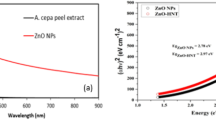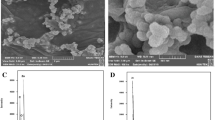Abstract
The reprocessing of tailings or gold mine waste dumps to extract gold has become an attractive proposition for mining houses worldwide because of the availability of gold which was not easily recovered using old technologies. This study seeks to exploit the novel properties of nanostructured materials in enhancing gold extraction from gold mine tailings. The beneficiation of slimes or tailings involved taking samples for mineralogical studies, synthesis of a novel adsorbent medium (nano C-MgO) prepared by using both chemical and mechano-synthesis methods, oxidative pre-treatment of flotation concentrates, cyanidation and final recovery of the precious metal from solution in a Carbon in Column (CIC) system. The nanocomposite adsorbent was studied by powder X-ray Diffraction (XRD) for structural analysis, Field Emission Scanning Electronic Microscopy (FESEM) for surface morphology, Energy-dispersive X-ray spectroscopy (EDX) for elemental analysis and Fourier Transform Infrared (FTIR) spectroscopy for chemical structure analysis. The Brunauer-Emmett-Teller (BET) Surface Area Analysis procedure was employed to determine the total specific surface area of the nano-adsorbent. Representative tailings samples of 100-500 g were obtained for different analytical investigations using a riffle splitter. The tailings grade was analysed using the Atomic Absorption Spectroscopy (AAS) technique and was found to be an average of 0.5 g/tonne. A comparative Pseudo-Equilibrium test showed that the novel C-MgO nano adsorbent had an average of 84% recovery against 70 % for convectional activated carbon. The average crystalline size of 4.5 -11nm for the majority of MgO nanoparticles was obtained using Debye-Scherrer formula. FESEM confirmed that nano MgO was porous in nature and highly agglomerated whilst EDX exhibited the successful synthesis of the nano-composite product. This work also shows that the nano-adsorbent presents a huge potential for application in the conventional processes for gold adsorption.
Similar content being viewed by others
References
Wills, B.A., Napier-Munn, T.J. and Anderson, C. Wills’ Mineral Processing Technology: An Introduction to the Practical Aspects of Ore Treatment and Mineral Recovery, 7th ed. (Elsevier Science & Technology Books, Queensland, 2006) p4.
J.K. Clafin, S.R. La Brooy, D.R. Preedy., A. Slater, and F. Urrutia et al, Fast-pay back reactivation of carbon from a floatation tails CIL circuit, The Southern African Institute of Mining and Metallurgy, World Gold Conference (2015), pp 337–348.
W. Srithammavu, MODELING OF GOLD CYANIDATION, Master of Science (Technology) Thesis, (2008) p7.
P.D. Kondos, G. Deschênes, R.M. Morrison, Hydrometallurgy. 39 (1995).
A. Kumar and H.M. Jena, RESULTS PHYS. 6, 651–658 (2016).
B. Nagappa and G.T. Chandrappa, MICROPOR MESOPOR MAT. 106, 212–218 (2007)
Q. Zhou., J.W. Yang, Y.Z., Wang, Y.H. Wu and D.Z Wang, MATER LETT. 62 (12), 1887–1889 (2008).
Particle Size and Strain Analysis by X-Ray Diffraction (2002). Available at: http://h-and-m-analytical.com/wp/wp-content/uploads/2015/04/size_strain.pdf (accessed 19 July 2017)
M.M. Sekhula, J. O. Okonkwo, C. M. Zvinowanda, N. N. Agyei and A. J.Chaudhary, J Chem Eng Process Technol. 3:2 (2012).
Author information
Authors and Affiliations
Rights and permissions
About this article
Cite this article
Madzokere, T.C., Musarurwa, G.T., Jere, G. et al. Adsorptive Recovery of Auro-Dicyanide Anions from Aqueous Solutions using Activated Carbon-Magnesium Oxide (C-MgO) Nanocomposite as Adsorbent. MRS Advances 3, 1955–1967 (2018). https://doi.org/10.1557/adv.2018.314
Published:
Issue Date:
DOI: https://doi.org/10.1557/adv.2018.314




